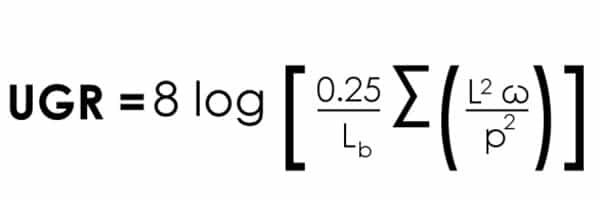UGR stands for Unified Glare Rating. A measurement that determines the glare caused by artificial light indoors. UGR value is expressed on a scale of 1 to 19, with lower values representing less glare and higher values representing more glare.
Lighting is important for people's comfort and well-being. However, it is also important to ensure that lighting is safe and does not cause glare. The Unified Glare Rating (UGR) is a measurement that determines the glare caused by artificial light indoors or, for example, in a car.
Scale from 1 to 19
UGR values are expressed on a scale from 1 to 19, with lower values representing less glare and higher values representing more glare. It is therefore important to keep the UGR value in the room as low as possible to avoid glare and associated discomfort. How is the UGR value determined?
How is the value calculated? This is based on several factors, including lighting height and distance, reflections from the room surface and light intensity. There are several ways to determine the UGR value, but the most commonly used method is the 'zonal cavity method'.
Several factors are taken into account, such as:
- Type light source:
The colour temperature and illuminance of the light source play an important role in determining the UGR value.
- room dimensions:
Larger rooms need more lighting to provide adequate illumination.
- Ceiling height:
Higher ceilings mean more space for lighting, which affects UGR values. These factors can be used to calculate a UGR value, which indicates whether lighting meets glare criteria.
What UGR value for inside the car?
For car lighting, a value of 19 or lower is recommended. This value is classified as "very low" and ensures good comfort and safety for the driver and other road users. It's important to know that some countries have specific requirements for the UGR value of car lighting, so it's always best to check the requirements in your region. In our blog on functional LED interior lighting, we delve into various options for safe indoor lighting.
What is an acceptable value indoors?
In indoor spaces, acceptable values between 19 and 22 are often assumed. It depends on the specific application and user expectations. For some applications, such as computer workstations, lower UGR values are recommended.
How can I lower the UGR value of my lighting?
There are various ways to reduce the UGR value of lighting, such as using lighting with controlled luminous flux, using light beams with a lower opening angle, and increasing the distance between the lighting and the surfaces in the room. Additionally, the use of diffuse lighting fixtures and the application of lighting controls (such as dimming) can contribute to a lower value.
Table showing UGR values and recommended applications:
| UGR Value | Application |
|---|---|
| 19 or lower | Computer workstations, offices, libraries, truck cab, car |
| 20-22 | General lighting in offices, conference rooms, schools, shops |
| 23-25 | Lighting in factory halls, warehouses, car parks |
| 26 or higher | Lighting in sports facilities, public lighting |
Please note that the recommended UGR value may depend on several factors, such as: Specific room conditions and user expectations. It is always advisable to refer to specific standards and regulations for specific applications.

If you are looking for functional LED lighting for vehicles, Tralert® offers an extensive range of LED interior lighting that provides safe light output.